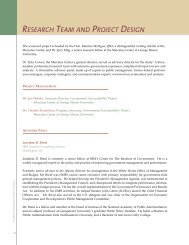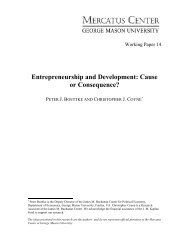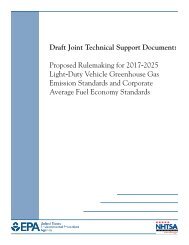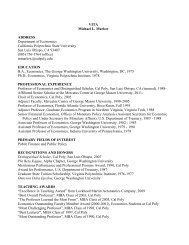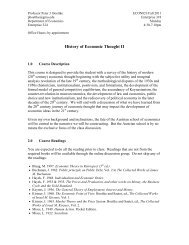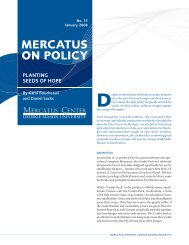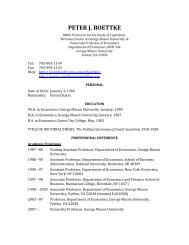A-La-Carte Pricing in the Airline Industry - Graduate Student ...
A-La-Carte Pricing in the Airline Industry - Graduate Student ...
A-La-Carte Pricing in the Airline Industry - Graduate Student ...
Create successful ePaper yourself
Turn your PDF publications into a flip-book with our unique Google optimized e-Paper software.
such a scenario faces strong <strong>in</strong>centives to position itself <strong>in</strong> <strong>the</strong> center of <strong>the</strong> distribution tocapture as many consumers as possible from <strong>the</strong> o<strong>the</strong>r firm. Despite a potential <strong>in</strong>crease <strong>in</strong> totalwelfare if each firm positions itself at oppos<strong>in</strong>g quarters of <strong>the</strong> l<strong>in</strong>e, thus reduc<strong>in</strong>g <strong>the</strong> distanceconsumers would have to travel, this outcome is untenable given each firm‘s <strong>in</strong>centives.Hotell<strong>in</strong>g po<strong>in</strong>ts out that real-world firms compet<strong>in</strong>g for customers distributed <strong>in</strong> a qualityspace validate his <strong>the</strong>ory: ―Buyers are confronted everywhere with an excessive sameness. Whena new merchant or manufacturer sets up shop he must not produce someth<strong>in</strong>g exactly like what isalready on <strong>the</strong> market. . . . But <strong>the</strong>re is an <strong>in</strong>centive to make <strong>the</strong> new product very much like <strong>the</strong>old, apply<strong>in</strong>g some slight change which will seem an improvement to as many buyers as possiblewithout ever go<strong>in</strong>g far <strong>in</strong> this direction‖ (54).Each airl<strong>in</strong>e‘s choice <strong>in</strong> product offer<strong>in</strong>gs can often be found to exhibit a number ofqualities of ―sameness‖ to <strong>the</strong> <strong>in</strong>dustry standard—most airl<strong>in</strong>es have similar seat pitch, similarcab<strong>in</strong> class offer<strong>in</strong>gs, etc. Hotell<strong>in</strong>g‘s classic model is, of course, an abstraction, especially due toa number of constra<strong>in</strong>ts on <strong>the</strong> model (such as normally distributed consumers and a one-productduopoly market). Salop (1979) elaborates on <strong>the</strong> Hotell<strong>in</strong>g model by position<strong>in</strong>g multiple firmson an <strong>in</strong>f<strong>in</strong>ite l<strong>in</strong>e or unit circle and adds ano<strong>the</strong>r outside commodity to <strong>the</strong> economy. Salop f<strong>in</strong>dsthat, <strong>in</strong> a similar manner to Hotell<strong>in</strong>g‘s model, a firm faces low <strong>in</strong>centive to provide productvariety relative to <strong>the</strong> social optimum (152). This leaves customers worse off than <strong>the</strong>y o<strong>the</strong>rwisecould have been <strong>in</strong> <strong>the</strong> total welfare-maximiz<strong>in</strong>g sett<strong>in</strong>g.While airl<strong>in</strong>es may face spatially distributed customers, unlike <strong>the</strong> firms <strong>in</strong> <strong>the</strong> Hotell<strong>in</strong>gand Salop models, <strong>the</strong>y do not charge constant per-unit prices for air travel. Ra<strong>the</strong>r than a l<strong>in</strong>earpric<strong>in</strong>g arrangement, airl<strong>in</strong>es charge different prices based on distance flown, time of day, and avariety of o<strong>the</strong>r supply and demand factors. A carrier‘s fares do not necessarily exhibit a l<strong>in</strong>ear26



